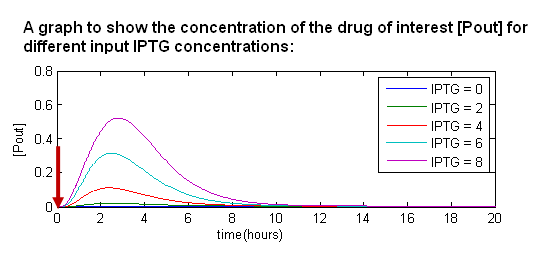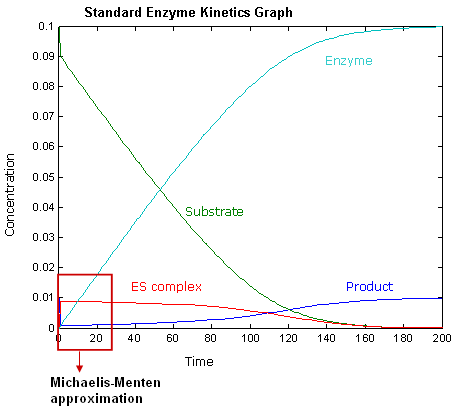Team:Imperial College London/Major results
From 2009.igem.org
(→Simulations: Chemoinduction/Module 1-Output yield of drug of interest) |
(→Simulations: Module 1 - Enzyme kinetics and dosage control) |
||
| Line 18: | Line 18: | ||
==Simulations: Module 1 - Enzyme kinetics and dosage control== | ==Simulations: Module 1 - Enzyme kinetics and dosage control== | ||
[[Image:II09_enzymekinetics.png|330px|left]]<br> | [[Image:II09_enzymekinetics.png|330px|left]]<br> | ||
| - | Many polypeptides of interest are enzymes. This means that detecting how much drug has been produced requires knowledge about their interaction with their respective substrates in the enzymatic assays. Here we assumed that enzymatic activity follows Michaelis-Menten kinetics [ | + | Many polypeptides of interest are enzymes. This means that detecting how much drug has been produced requires knowledge about their interaction with their respective substrates in the enzymatic assays. Here we assumed that enzymatic activity follows Michaelis-Menten kinetics [1-3]. This means that we can directly relate enzymatic activity to the required dosage for successful administration of the polypeptide of interest. <br> |
<b>Dosage Calculations:</b><br> | <b>Dosage Calculations:</b><br> | ||
Tianyi upload once we work out activity or whatever is necessary!<br><br><br><br> | Tianyi upload once we work out activity or whatever is necessary!<br><br><br><br> | ||
Revision as of 21:39, 20 October 2009

Major Results
This page contains some, but not all of our major results and highlights of our simulations. This is not complete. More results will be presented at the jamboree.
Simulations: Chemoinduction/Module 1-Output yield of drug of interest
Our simulation results indicate that increasing input amounts of IPTG result in a greater yield of polypeptide drug of interest (See simulation results). We did an experiment to study how different input concentrations of IPTG affect cell growth, and concluded that IPTG has no significant effect on cell growth within the ranges we are using(IPTG growth curves). Therefore, we can conclude that increasing IPTG concentration initially will have a positive contribution to our dosage.

Note 1: Results from these simulations were to be tied up with data from our LacI-RFP testing construct (See our part K200019. Unluckily, this part of the construct was not sent correcty from the registry, so testing again was not possible before the wiki-freeze deadline.
Note 2: Parameters used in the system are arbitrary. For a justification see the system stability analysis.
Experimental: Module 2 - Encapsulation growth curves
Dependent on lab results today
Experimental: Autoinduction - Diauxic growth curve and CRP GFP
Here we can pick a diauxic growth curve and compare directly to a simulation (if I manage to make one work!! :-S)
Simulations: Module 1 - Enzyme kinetics and dosage control
Many polypeptides of interest are enzymes. This means that detecting how much drug has been produced requires knowledge about their interaction with their respective substrates in the enzymatic assays. Here we assumed that enzymatic activity follows Michaelis-Menten kinetics [1-3]. This means that we can directly relate enzymatic activity to the required dosage for successful administration of the polypeptide of interest.
Dosage Calculations:
Tianyi upload once we work out activity or whatever is necessary!
Experimental: Module 3 - Thermoinducible promoter
Need Matthieu's latest processed data
Conclusion
Need some inspiration here guys!


 "
"




